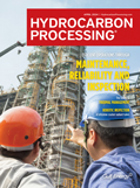Safety
Project Management: Efficiently expanding a specialty chemical company
COIM, a specialty chemical company, decided to expand its production capacity in the U.S. to supplement growing market and economy.
Reliability: Strainers and thoughtful testing: Piping initiatives worth considering
In two separate cases, foresight in the use of strainers on piping and following proper procedures for hydrostatic testing are recommended to preserve the integrity of offshore platforms.
Effectively clean air fan coolers with water and steam
In many refineries and petrochemical plants, air fan coolers (AFCs) become a major bottleneck to increasing plant capacity. Many plants suffer from lower heat duty than designed, especially during the summer months, which can lead to lower plant capacity.
Leveraging modern flow technologies to improve safety in refineries
The refining industry is facing increased pressures, such as crude oil supply changes, changing product distributions and increasing regulations. These pressure points create a highly competitive market where refiners are looking for options that include digitally transforming operations and adapting new technologies to enhance safety and improve uptime, flexibility and efficiency, while securing their competitive position in a dynamic market. Improving personnel and process safety remains a top focus area for refiners.
Industry Perspectives: The Main Column—Hydrocarbon Processing's new podcast series
In December 2019, <i>Hydrocarbon Processing's</i> launched its new podcast series: The Main Column. The podcast series will feature the latest in hydrocarbon processing industry (HPI) trends, technology developments, engineering and operations.
Editorial Comment: Adopting digital technologies to enhance operations
What is the future of refining and petrochemical operations? One trend that has been the focus of many articles, whitepapers and conference presentations is the digital transformation of the hydrocarbon processing industry (HPI).
Inspection: A practical approach to internal inspection of pressure equipment
Internal inspections of pressure equipment involve a full inspection of the equipment. Inspection engineers and inspectors depend heavily on internal inspections to retrieve useful data, which includes information on active degradation mechanisms, corrosion rates, remaining equipment life, failure occurrences and failure expectations, among other critical details.
Project Management: How human intelligence and AI are driving project planning in the oil and gas industry
The science of project planning has something of a tenuous reputation. How often do large oil and gas capital expenditure (CAPEX) projects really come in according to plan? Almost never. Indeed, 30% of respondents to a 2018 PWC survey said they had experienced cost overruns of 10%–50% on their Middle East capital projects.
LOPA: A comprehensive analytical tool for deriving SIL targets and applicability review
Many industrial facilities, especially those in the chemical, oil and gas and petroleum industries, involve inherent risks in operations due to the processing of material that is hazardous in nature. It is necessary to precisely identify and analyze hazards, operability issues, associated risks and consequences.
Digital: How digital tools improve access to device information
Welcome to the future! The plant runs fully automated; robots glide silently back and forth, ensuring an optimized process; and your maintenance technician—with a few keystrokes—can tell you exactly how each piece of equipment is running. The promise of the Industrial Internet of Things (IIoT) has been delivered.

- HIF Global selects Johnson Matthey’s methanol technology for the largest e-methanol plant in South America 5/16
- BASF expands its biomass balance portfolio for selected chemical intermediates 5/16
- INEOS Inovyn launches next-generation recycling pilot plants to strengthen Europe’s PVC recycling 5/16
- How Europe reduced its greenhouse gas emissions in 2023 5/16
- Plug signs contract with Allied Green Ammonia to supply H2 for planned ammonia facility in Australia 5/16
- HSBC to arrange funds for $1.49-B expansion project at Vietnam's Binh Son refinery 5/16




